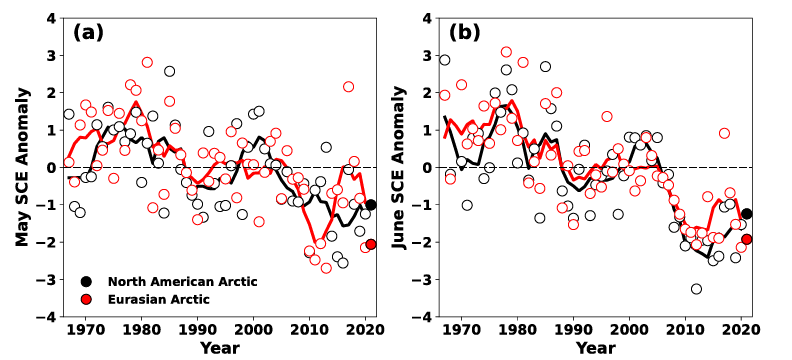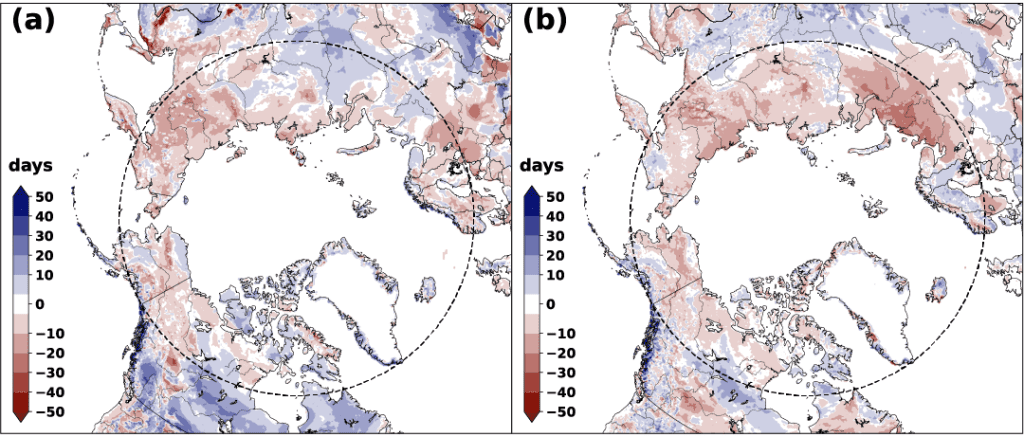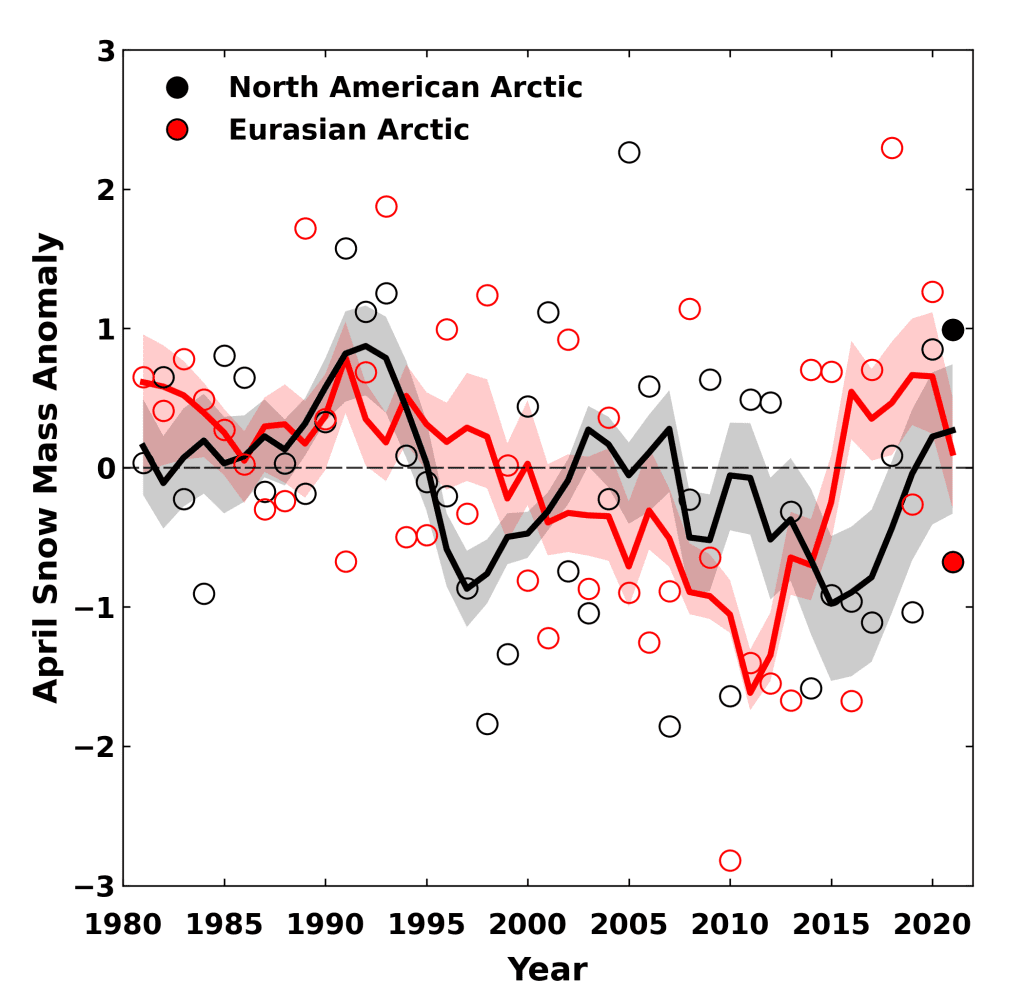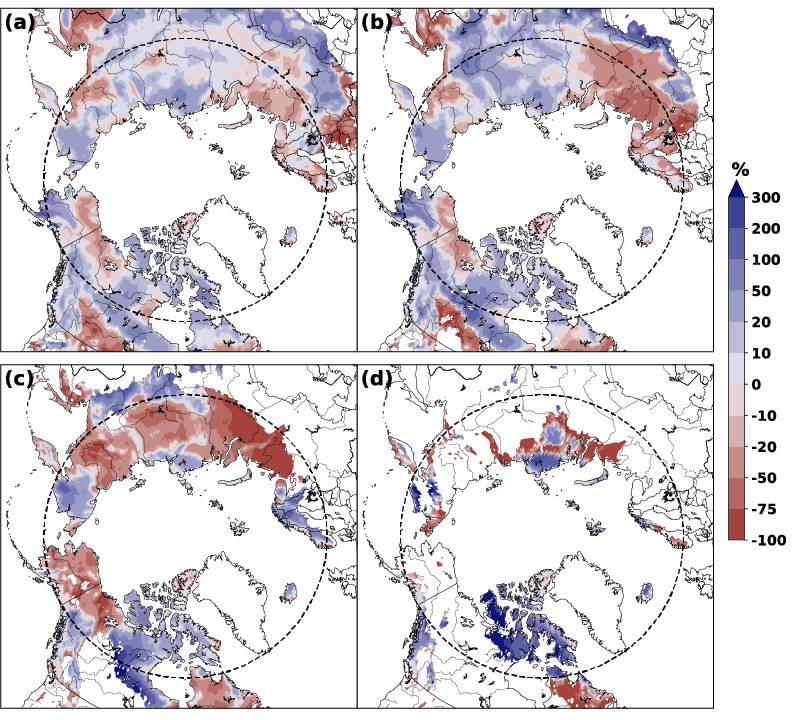L. Mudryk1, A. Elias Chereque2, C. Derksen1, K. Luojus3, and B. Decharme4
1Climate Research Division, Environment and Climate Change Canada, Toronto, ON, Canada
2Department of Physics, University of Toronto, Toronto, ON, Canada
3Arctic Research Centre, Finnish Meteorological Institute, Helsinki, Finland
4Météo-France/CNRS, Centre National de Recherches Météorologiques, Toulouse, France
Highlights
- Eurasian Arctic snow cover extent (SCE) anomalies were strongly negative in both May (5th lowest in the record since 1967) and June (3rd lowest) 2021. North American Arctic spring 2021 SCE anomalies were also below average (14th and 16th lowest, respectively).
- The summer 2020 snow-free period across Eurasia was the longest since at least 1998.
- Since 2006, North American June SCE has been below the long-term average every year, while Eurasian June SCE has been below the long-term average for every year but one.
Introduction
Many components of the Arctic land surface are directly influenced by snow cover from autumn through spring, including the surface energy budget (Flanner et al. 2011), ground thermal regime (with implications on the carbon cycle; Natali et al. 2019), permafrost (Walvoord and Kurylyk 2016), and terrestrial and freshwater ecosystems (Bokhorst et al. 2016). Even following the snow cover season, the influence of spring snow melt timing persists through impacts on river discharge timing and magnitude, surface water, soil moisture, vegetation phenology, and fire risk (Meredith et al. 2019). The assessment provided here is based on multiple datasets derived from satellite observations and snowpack models driven by atmospheric reanalyses. Collectively, this approach provides a reliable picture of Arctic snow cover variability over the last five decades.
We characterize snow conditions across the Arctic land surface using three quantities: how much total land area is covered by snow (snow cover extent – SCE), how much of the year snow covers the land surface (snow cover duration – SCD), and how much total water is stored in solid form in the snowpack. This last quantity is determined from the snow water equivalent (SWE), which is the product of snow depth and density. SWE can be aggregated across the Arctic land surface to provide an estimate of the total mass of water stored by snow. We examine each of these quantities in turn for the Arctic snow season spanning autumn 2020 through spring 2021.
Snow cover extent and duration
SCE anomalies (relative to the 1981-2010 climatology) in spring 2021 are shown separately for the North American and Eurasian terrestrial sectors of the Arctic in Fig. 1. Eurasian Arctic anomalies were strongly negative in May (5th lowest in the record since 1967) and June (3rd lowest). North American Arctic spring SCE anomalies in 2021 were also below average (14th and 16th lowest, respectively).

Snow cover duration (SCD) anomalies across the Arctic region for the 2020-2021 snow season are shown in Fig. 2 for both snow onset and snow melt periods of the year (see Methods and data). Onset anomalies indicate snow cover during autumn 2020 began later than normal over much of Eurasia, particularly in eastern Siberia, as well as over much of Alaska and the western Canadian Arctic (Fig. 2a). Coupled with the early spring melt in 2020 (see last year’s Arctic Report Card: Mudryk et al. 2020a), the complete 2020 snow-free period was the longest since the start of the database in 1998 across Eurasia and the second longest across the entire Arctic, with implications for Arctic vegetation (see essay Tundra Greenness). Spring 2021 (Fig. 2b) also had early snow melt and hence shorter SCD over almost the entire Arctic. In particular, across broad expanses of Eurasia the duration of the spring snow-free period was 30-50% longer than normal. As during the spring 2020 snow season, the early Eurasian melt in 2021 was driven by persistent, above-average temperatures during April-June (see essay Surface Air Temperature). While the early melt during 2021 was more extensive across Eurasia than the previous year, it was slightly less intense, resulting in near—but not record—low Eurasian Arctic SCE during June 2021.

Snow mass and snow water equivalent
For Arctic regions as a whole, snow mass tends to peak seasonally during April, when snowfall has accumulated since the preceding autumn but before increasing temperatures during May and June lead to snow melt. Snow mass anomalies for April 2021 (Fig. 3) indicate above normal total snow accumulation in the North American Arctic and slightly below average accumulation over the Eurasian Arctic. Figure 4 illustrates SWE varied regionally from just before peak (March) through the end of the melt period (June). The above normal April snow mass in North America (Fig. 3) is already apparent in March SWE across much of the region (except for parts of the mainland adjacent to the Beaufort Sea). Over Eurasia, snow accumulation through March was near-normal: above average SWE in central and eastern Siberia was balanced by below average SWE in western Russia and Scandinavia. The high spring temperatures previously mentioned drove SWE reductions across western Eurasia in April (see April-June temperature anomaly pattern Fig. 2c in essay Surface Air Temperature). By May, SWE was below normal across most of the continent. In contrast to Eurasia, SWE across North America generally remained above normal amounts through June particularly in the Canadian Arctic Archipelago. However, even where SWE was seasonally above average, complete snow melt tended to occur slightly earlier than usual over most of the region (apparent by comparing Fig. 2b with Figs. 4c and 4d). This combination of increased snow accumulation (expressed as April SWE in Fig. 4b) but early snow melt (expressed by shorter SCD in Fig. 2b) is consistent with the expected changes to Arctic snow cover in a warmer Arctic (Meredith et al. 2019), reflected also in earlier and larger peak river discharge as observed over Eurasia during spring 2020 (see essay River Discharge).


Summary and long-term trends
In summary, snow accumulation during the 2020/21 winter was near normal across the Eurasian Arctic and above normal across the North American Arctic. Regardless of the seasonal accumulation, spring snow extent has been persistently below normal for the last 15 years. Since 2006, North American June SCE has been below the long-term average every year, while Eurasian June SCE has been below the long-term average for all but one year. Long-term trends for total Arctic SCE, derived from the data presented in Fig. 1, are -3.8 ± 1.9% decade-1, and -15.5 ± 5.8% decade-1 for May and June, respectively (1981-2021). These trends are more negative compared to a range of other sources, as discussed in Mudryk et al. (2017, 2020b). The April trend in Arctic snow mass over the 1981-2021 period is more moderate, reflecting larger interannual variability. Calculated from the data presented in Fig. 3, the snow mass trend is -2.0 ± 1.7% decade-1, representing a decrease in seasonally stored water of close to 10% over the entire Arctic since 1981.
Methods and data
Snow cover extent (SCE) anomalies are derived from the NOAA snow chart climate data record, which extends from 1967 to present (Estilow et al. 2015; Robinson et al. 2012). Monthly anomalies of total areal snow cover over land for a given Arctic sector (North America or Eurasia, > 60° N) are computed and standardized relative to the 1981-2010 period (each observation differenced from the mean and divided by the standard deviation and thus unitless).
Snow cover duration (SCD) fields are derived from the NOAA daily Interactive Multisensor Snow and Ice Mapping System (IMS) snow cover product (U.S. National Ice Center 2008). Anomalies in the total number of days with snow cover were computed separately for each half of the snow season: August 2020 to January 2021, referred to as “onset period,” and February 2021 to July 2021, referred to as “melt period.” IMS availability starts in 1998, so a 1999-2018 climatological period is used (including information from August-December 1998 for snow onset). Anomalies for each season are presented as percent differences from the climatological number of snow-free days. In the Arctic, this varies from approximately three months near 60° N, to approximately two months at 70° N, and decreases to less than a month over the Canadian Arctic Archipelago. Because the Arctic is generally always snow covered between November and April, Arctic region snow onset anomalies are indicative of conditions during September and October, while Arctic region snow melt anomalies are indicative of conditions during May and June.
Four snow water equivalent (SWE) analyses were used to generate multi-dataset SWE fields from March-June for the 1981-2021 period: (1) the European Space Agency Snow CCI SWE version 1 product derived through a combination of satellite passive microwave brightness temperatures and climate station snow depth observations (Luojus et al. 2020); (2) the Modern-Era Retrospective Analysis for Research and Applications version 2 (MERRA-2, GMAO 2015; Gelaro et al. 2017) daily SWE fields; (3) SWE output from the ERA5-Land analysis (Muñoz Sabater 2019); and (4) the physical snowpack model Crocus (Brun et al. 2013) driven by ERA5 meteorological forcings. Reduced availability of climate station snow depth measurements limits the accuracy of the Snow CCI SWE product during May and June, hence we only use it during March and April. An approach using gridded products is required because in situ observations alone are too sparse to be representative of hemispheric snow conditions, especially in the Arctic where stations are particularly sparse. We consider multiple datasets because averaging multiple SWE products has been shown to be more accurate when validated with in situ observations (Mortimer et al. 2020). The ensemble-mean SWE field is used to calculate monthly SWE anomalies relative to the 1981-2010 period, and present them as percent differences. For April, the SWE fields for each product are also aggregated across Arctic land regions (> 60° N) for both North American and Eurasian sectors to produce multiple estimates of April snow mass. These monthly snow mass values are used to calculate standardized anomalies relative to the 1981-2010 period for each data product. The standardized anomalies are then averaged to produce an ensemble-mean time series.
Acknowledgments
ERA5-Land data (Muñoz Sabater 2019) were downloaded from the Copernicus Climate Change Service (C3S) Climate Data Store. The results contain modified Copernicus Climate Change Service information 2020. Neither the European Commission nor ECMWF is responsible for any use that may be made of the Copernicus information or data it contains.
References
Bokhorst, S., and Coauthors, 2016: Changing Arctic snow cover: A review of recent developments and assessment of future needs for observations, modelling, and impacts. Ambio, 45, 516-537, https://doi.org/10.1007/s13280-016-0770-0.
Brun, E., V. Vionnet, A. Boone, B. Decharme, Y. Peings, R. Valette, F. Karbou, and S. Morin, 2013: Simulation of Northern Eurasian local snow depth, mass, and density using a detailed snowpack model and meteorological reanalyses. J. Hydrometeor., 14, 203-219, https://doi.org/10.1175/JHM-D-12-012.1.
Estilow, T. W., A. H. Young, and D. A. Robinson, 2015: A long-term Northern Hemisphere snow cover extent data record for climate studies and monitoring. Earth Syst. Sci. Data, 7, 137-142, https://doi.org/10.5194/essd-7-137-2015.
Flanner, M. G., K. M. Shell, M. Barlage, D. K. Perovich, and M. A. Tschudi, 2011: Radiative forcing and albedo feedback from the Northern Hemisphere cryosphere between 1979 and 2008. Nat. Geosci., 4, 151-155, https://doi.org/10.1038/ngeo1062.
Gelaro, R., and Coauthors, 2017: The Modern-era retrospective analysis for research and applications, Version 2 (MERRA-2). J. Climate, 30, 5419-5454, https://doi.org/10.1175/JCLI-D-16-0758.1.
GMAO (Global Modeling and Assimilation Office), 2015: MERRA-2tavg1_2d_lnd_Nx:2d, 1-Hourly, Time-Averaged, Single-Level, Assimilation, Land Surface Diagnostics V5.12.4, Goddard Earth Sciences Data and Information Services Center (GESDISC), accessed: 11 Aug 2021, https://doi.org/10.5067/RKPHT8KC1Y1T.
Luojus, K., and Coauthors, 2020: ESA Snow Climate Change Initiative (Snow_cci): Snow Water Equivalent (SWE) level 3C daily global climate research data package (CRDP) (1979-2018), version 1.0. Centre for Environmental Data Analysis, accessed: 19 Jul 2021, https://doi.org/10.5285/fa20aaa2060e40cabf5fedce7a9716d0.
Meredith, M., and Coauthors, 2019: Polar Regions. IPCC Special Report on the Ocean and Cryosphere in a Changing Climate, H. -O. Pörtner, and co-editors, in press, https://www.ipcc.ch/srocc/.
Mortimer, C., L. Mudryk, C. Derksen, K. Luojus, R. Brown, R. Kelly, and M. Tedesco, 2020: Evaluation of long-term Northern Hemisphere snow water equivalent products. Cryosphere, 14, 1579-1594, https://doi.org/10.5194/tc-14-1579-2020.
Mudryk, L. R., P. J. Kushner, C. Derksen, and C. Thackeray, 2017: Snow cover response to temperature in observational and climate model ensembles. Geophys. Res. Lett., 44, 919-926, https://doi.org/10.1002/2016GL071789.
Mudryk, L., A. Elias Chereque, R. Brown., C. Derksen, K., Luojus, and B. Decharme, 2020a: Terrestrial Snow Cover. Arctic Report Card 2020, R. L. Thoman, J. Richter-Menge, and M. L. Druckenmiller, Eds., https://doi.org/10.25923/p6ca-v923.
Mudryk, L., M. Santolaria-Otín, G. Krinner, M. Ménégoz, C. Derksen, C. Brutel-Vuilmet, M. Brady, and R. Essery, 2020b: Historical Northern Hemisphere snow cover trends and projected changes in the CMIP6 multi-model ensemble. Cryosphere, 14, 2495-2514, https://doi.org/10.5194/tc-14-2495-2020.
Muñoz Sabater, J., 2019: ERA5-Land hourly data from 1981 to present. Copernicus Climate Change Service (C3S) Climate Data Store (CDS), accessed 11 Aug 2021, https://doi.org/10.24381/cds.e2161bac.
Natali, S. M., and Coauthors, 2019: Large loss of CO2 in winter observed across the northern permafrost region. Nat. Climate Change, 9, 852-857, https://doi.org/10.1038/s41558-019-0592-8.
Robinson, D. A., T. W. Estilow, and NOAA CDR Program, 2012: NOAA Climate Data Record (CDR) of Northern Hemisphere (NH) Snow Cover Extent (SCE), Version 1 [r01]. NOAA National Centers for Environmental Information, accessed: 8 Jul 2021, https://doi.org/10.7289/V5N014G9.
U.S. National Ice Center, 2008: IMS Daily Northern Hemisphere Snow and Ice Analysis at 1 km, 4 km, and 24 km Resolutions, Version 1. Boulder, Colorado USA. NSIDC: National Snow and Ice Data Center, accessed: 11 Aug 2021, https://doi.org/10.7265/N52R3PMC.
Walvoord, M. A., and B. L. Kurylyk, 2016: Hydrologic impacts of thawing permafrost—a review. Vadose Zone J., 15, vzj2016.01.0010, https://doi.org/10.2136/vzj2016.01.0010.
January 5, 2022

